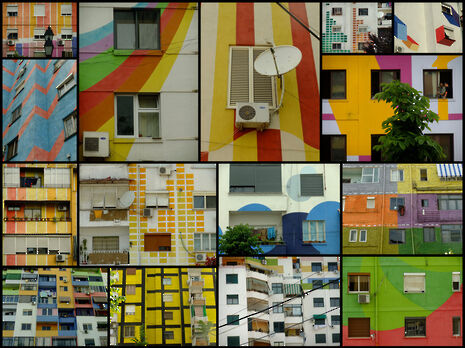Critical Colour
We’ve only got one colourful building in central Cambridge. ‘Where are the rest?’, asks Yates Norton

If you want to change the character of your room, usually changing the colour will do. If, on the other hand, a blighted city, ravaged by ruthless urban campaigns needs transforming, it’s usually a bulldozer rather than the brush that does the work.
For the population of one city, Tirana (Albania) who suffered constant incompetent demolition and rebuilding, the decisions of which were usually out of their hands, the idea of more full-bodied structural intervention was hardly eagerly anticipated.
For the city’s mayor, Edi Rama, colour was the key in transforming the city. Subsidising paint and encouraging the population to paint parts of the tower blocks, the city soon changed from ex-soviet paean to concrete to a mosaic of colour. Rama’s opponents accused him of mere aestheticisation, a failure to engage in a more virile way with the city’s people and its space. Colour was associated with ornament - that thing so brutally critiqued by Adolf Loos in Ornament and Crime - and banished as bourgeois. Colour was nebulous rather than firm, rhetorical play rather than substance.
Its merely optical re-renderings of space denounced as spectacle, pandering and reflecting an obsession with packaging and surface. But these were themselves superficial readings, merely rehearsing tired neo-platonisms and cursory dismissals of anything that smacks of an incipient ‘superficialising’ of all domains of life. The accusation revealed a dreaded fear of the eye, a suspicion of optical play: how can something so insubstantial as colour so transform our interaction in space?
Lacking corporeal ‘proof’, the transformation of space and environment by colour implies a facile duping of our cognitive capacities through mere illusionistic play. Believing in the transformative capacity of colour in space is like believing that a blue steak really does change its flavour. But the fact is that we do see. Colour is a fact of presence, not merely an unnecessary veil to some essential body behind.
The Lockean distinction between secondary and primary qualities is an entrenched dichotomy that has facilitated a measure of suspicion of the secondary as handmaiden to the first. And handmaiden is the word, for the prejudice against colour is a patriarchal prejudice which sustains the binary between feminine play and decoration against masculine tectonic integrity.
Their interaction and overlay is unthinkable in the discourse that maintains their absolute separation. Histories of modernist architecture have eschewed the theme colour in order to maintain its apparently ‘essential’ patriarchal core, (with De Stijl as a notable exception).
Only recently has Le Corbusier be appraised as a colourist. Previously it might have been seen as a violation of his architectonic integrity. If colour were introduced, we’d be in the world of phenomenological play rather than firm, rational structure. Cities and buildings have been drawn up with lines and grids. The great modernist regimes of urban tabula rasa and absolute evisceration from Haussmann to Ceausescu precipitated a brutally sudden change in the social structure of space. The ideologies that drive such aggressive tabula rasa are no longer viable in a world which might resist social change effected by a dominant hegemonic force. Colour is subtler, perhaps not in tone, but certainly in the transformation of space.
By relieving structures of pure tectonic integrity – key to Modernist tenets of ‘truth’ and ‘honesty’ - colour is able to change the dynamic of architecture’s intervention in our spaces. This is not to ask for weak architecture; but as an agent of transformation that elides the pitiless act of complete destruction and rebuilding, colour in architecture and space can operate on a subtler dialectic that transmutes the qualities of environment and building.
We can no longer sustain complete urban renewal on the model of Modernist tabula rasa: its ecological and sociological implications are too great and negative. Change can be effected by means which circumvent capital driven industrial forces that impose their physical and metaphorical structures on existing communities and spaces.
If colour can transform architecture, can transform our space, simply through paint and light, the opportunities for renewal are ecological, and most importantly, available to all. Colour was picked up in postmodernist architecture, but an imaginative and subtle use of it has remained far from central to architectural and urban practice. The standard lexicon of urban transformation - pick axes, mallets and bulldozer – still dominate today. Let it now be paint and light.
 News / Fitz students face ‘massive invasion of privacy’ over messy rooms23 April 2024
News / Fitz students face ‘massive invasion of privacy’ over messy rooms23 April 2024 News / Cambridge University disables comments following Passover post backlash 24 April 2024
News / Cambridge University disables comments following Passover post backlash 24 April 2024 Comment / Gown vs town? Local investment plans must remember Cambridge is not just a university24 April 2024
Comment / Gown vs town? Local investment plans must remember Cambridge is not just a university24 April 2024 News / Students organise Cambridge’s first female and non-binary club night25 April 2024
News / Students organise Cambridge’s first female and non-binary club night25 April 2024 Arts / ‘Walking around Robinson is automatically humbling’: college architecture and the psyche24 April 2024
Arts / ‘Walking around Robinson is automatically humbling’: college architecture and the psyche24 April 2024





